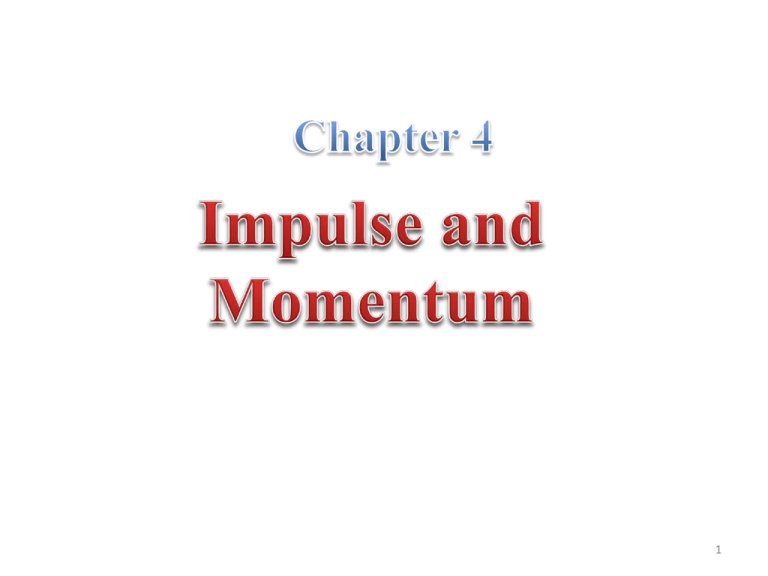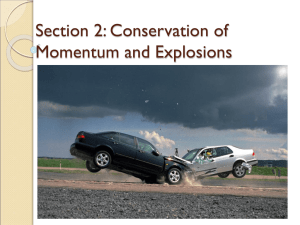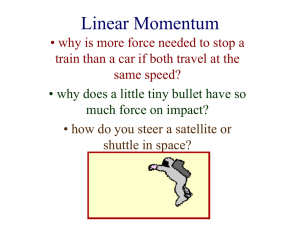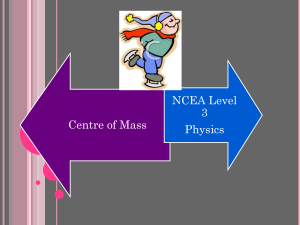ch-4 Impulse and Momentum
advertisement

1 Momentum: By Momentum, we mean “Inertia in Motion” or more specifically, the mass of an object multiplied by its velocity. Momentum = mass × velocity or in shorthand notation, Momentum = m × v P=m×v When direction is not an important factor, we can say Momentum = mass × speed S.I Unit of Momentum : Kg-m/sec or N-sec Impulse Changes Momentum: The greater the impulse exerted on some thing, the greater the change in momentum. The exact relationship is, Impulse = Change in Momentum or in shorthand notation, Ft = Δ(mv) Where Δ is the symbol for “change in” Law of Conservation of Momentum If no net external force acts on a system, the total linear momentum of the system cannot change. Or It can be stated that The sum of a system's initial momentum is equal to the sum of a system's final momentum. The law of conservation of momentum can be mathematically expressed as Total momentum before collision = Total momentum after collision P1(initial) + P2(initial) = P1(final) +P2(final) Impulse Changes Momentum: The greater the impulse exerted on some thing, the greater the change in momentum. The exact relationship is, Impulse = Change in Momentum or in shorthand notation, Ft = Δ(mv) Where Δ is the symbol for “change in” 11 Example • An average force of 300 N acts for a time of 0.05 s on a golf ball. What is the magnitude of the impulse acting on the ball? Solution Given data: F 300N t 0.05 s, J? J Ft J (300 N ) (0.05 s) 15 N .s 12 • A bowling ball of mass 5kg travels at 2m/s and a tennis ball with mass of 150g. Can both balls have the same momentum? If yes at what speed must the tennis ball travel to have same momentum? solution V =2m/s Given data: m 150g 0.150kg, M 5kg , V 2m / s m = 150g M = 5kg p BB pTB , v ? MV m v MV (5kg )(2m / s) v 66m / s m 0.150kg 13 • A baseball of mass 0.15 kg has an initial velocity 0f -20 m/s (moving to the left) as it approaches a bat. It is hit straight back to the right and leaves the bat with a final velocity of +40 m/s. (a) Determine the impulse applied to the ball by the bat. (b) Assume that the time of contact is 1.6 10 sec , find the average force exerted on the ball by the bat. (c) How much is the impulse exerted by the ball on the bat? 3 14 Solution (1) Apply the impulse-momentum theorem J mvf mvi (0.15kg)(40m / s) (0.15kg)(20m / s) 9 kg m / s (2) Apply the equation that defines impulse J Ft F 9 kg m / s J 1500N t 0.0060s (3) Apply Newton’s third law of action and reaction and get Impulse exerted on the bat by the ball equals -9 kg m/s. The negative sign indicates a direction to the left of the origin of coordinate system. 15 Law of Conservation of Momentum If no net external force acts on a system, the total linear momentum of the system cannot change. Or It can be stated that The sum of a system's initial momentum is equal to the sum of a system's final momentum. The law of conservation of momentum can be mathematically expressed as Total momentum before collision = Total momentum after collision P1(initial) + P2(initial) = P1(final) +P2(final) Applications Recoil of a gun: why a rifle recoils when a bullet is fired? A 10 g bullet is fired from a 3 kg rifle with speed of 500 m/s. What is (a) the initial momentum of the system (bullet and rifle)? And (b) the recoil speed of the rifle? p b ) i mb v b i (0.010g ) 0 0 p r ) i m r v ri (3kg ) 0 0 p bi p ri 0 0 0 p bf p rf p bi p ri 0, b=bullet r=rifle i=initial f=final p bf p rf 0, or p rf p bf (0.010kg ) (500m / s ) 5kg m / s 17 A 10 g bullet is fired from a 3 kg rifle with speed of 500 m/s. What is (a) the initial momentum of the system (bullet and rifle)? And (b) the recoil speed of the rifle? m1 = 3 kg m2 = 10 gm = 0.01 kg v1i = 0 m/sec (before firing) v2i = 0 m/sec (before firing) v2f = 500 m/sec (after firing) P=? v1f = ? (after firing) 18 • Elastic Collision Is a collision in which the total kinetic energy of the collided objects after collision equals the total kinetic energy before collision. P1i + P2i = P1f + P2f K1i + K2i = K1f + K2f The collided object bounce a part and return to their original shape without a permanent deformation 19 • Inelastic Collision - Is one in which the total kinetic energy of the collided objects after collision is not equal to the total kinetic energy before collision. The two object experience a permanent deformation in their original shape P1i + P2i = P1f + P2f K1i + K2i ≠ K1f + K2f - In completely inelastic collision, the two objects coupled and move as a one object after collision In both collisions, conservation of momentum is applied 20 Example on Elastic collision • A ball of mass 0.6 kg traveling at 9 m/s to the right collides head on collision with a second ball of mass 0.3 kg traveling at 8 m/s to the left. After the collision, the heavier ball is traveling at 2.33 m/s to the left. What is the velocity of the lighter ball after the collision? solution Given Data m1 0.6kg, v1 9m / s, m2 0.3kg, v2 8m / s, v1 2.3m / s, v2 ? m1 v 1 m 2 v 2 m1 v1 m 2 v 2 v 2 m1 v1 m 2 v 2 m1 v1 (0.6kg )(9m / s) (0,3kg )(8m / s) (0.6kg )(2.3m / s ) m2 0.3kg v 2 14,6m / s 21 • A kg railroad car traveling at 8 m/s to the east as shown in the drawing below is collided with another car of the same mass and initially at rest and couple with it. What is the velocity of the coupled system of cars after the collision? m1 m2 1.75104 kg, v1 8m / s, v 2 0, V ? m1 v1 m 2 v 2 (m1 m 2 )V V m1 v1 m 2 v 2 m v 0 1 1 3.5m / s m1 m 2 m1 m 2 22









